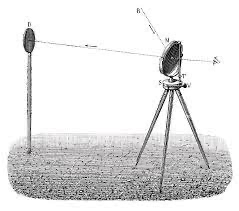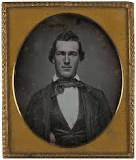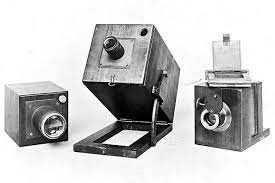Camera Obscura & Pinhole photography:
Camera obscura also known as pinhole photography is created by using a dark room which has a hole in one of the sides of the wall, after around half an hour to an hour what ever is on the outside of the box will project through the hole and an image of it will be created and inverted on the opposite wall.
The first written account of the technique was invented by Mo-tuz who was a Chinese philosopher. He noticed that the light travelled through to create a replicate of the original image. However there were many scientists involved in the Camera obscura, Alhazen is said to be the main inventor and he did experiments with candles, figuring out that the light that entered the hole traveled in straight lines and inverted. Many artists used the technique to trace the outlines of buildings or trees for example which made it very important back then as it allowed them to perfect their pieces.

Nicephore Niepce & Heliography:
Niepce is known as one of the most important figures in the history and invention of photography, the image below is the oldest image that still exists which was taken on a camera which he took. It is a little hard to tell what the image is, but it is a view of building rooftops in France taken from inside his house in Chalons-sur-Saône. He was a French inventor and in 1807 he and his brother invented the world’s first internal combustion engine. Following this he invented a heliographic image in 1827. This was an old process whereby you produce an image on a metal plate by engraving it. The technique is still used today however less for photography and more for engraving etc. Niepce was a very important part of the invention of photography and is still widely known to the day for his work.


Louis Daguerre & Daguerreotype:
Louis Daguerre was also a big name in the invention of photography. He was a French artist and photographer and like many of the others involved he named his invention after himself calling it the daguerreotype. He invented it in 1839 and it was the process which allowed people to create a highly detailed image on a copper sheet meaning they could preserve the image seen inside a Camera Obscura. To produce a daguerreotype the model has to sit still for around 10-15 minutes so that the image comes out clearly and the model is in focus. This being in mind, it makes it hard to produce portraits in such way, and is better for other types of images.


Henry Fox Talbot & Calotype:
William Henry Fox Talbot was a British photography inventor. It was in 1835 when he discovered how to make and fix images through the action of light and chemistry on paper, and produced the first photographic negative to have survived to this day. This process was a big deal at the time because it allowed photographers to make multiple prints of an image. It was called the calotype and it allowed the time of the of exposure for the camera to be reduced to only one or two minutes. The calotype was able to reproduce image by simple contact printing as opposed to the daguerreotype which colour only replicate image by using a camera. The very first model of the calotype was a sheet of silver chloride coated paper that was exposed to light in a camera obscura, the areas of the paper that were hit by light became darker which yielded a negative image.


Robert Cornelius & self-portraiture:
Robert Cornelius was an American photographer and was also a big name in the invention and development of photography. He was who designed the photographic plates for the first portrait image taking in the USA in 1839. He then operated two of the earliest photography studios between 1841 and 1843, and within them he came up with way to reduce the exposure time when photographing. To take them image he set up his mini studio in the back of his families store in Philadelphia. He removed the lens cap of the camera and then sat in the frame for a minute before he covered the lens up again.

Julia Margaret Cameron & Pictorialism:
Julia Margaret Cameron was knows for her soft-focus, close up portraits of famous Victorian men and women. she became interested in the topic in in the late 1850’s and began photographing in the 1860’s after she was gifted a camera as a present in 1863 and after that she created a large body of work capturing the men and women’s characteristics and beauty. She was a very inventive woman and used an old chicken coop that she cleared out as her first studio. Whilst her photography career was short she made around 900 images over the time period of 12 years. Her portraits of famous men in particular have been greatly praised for being extraordinarily powerful.

Henry Mullins & Carte-de-Visit:
Henry Mullins moved to Jersey in 1848 when he set up a studio in the Royal Square. He worked with another photographer named Mr Millward for the first year and after that he worked alone in the same original studio for the next twenty six years. He also worked in London in 1860 briefly, but most of his work came from locals in Jersey who would pay him to have their portrait done by him. Mullins’ work was also displayed in the form of Dimond cameos, whereby he took different portraits of the same person looking in different directions and then presented them in the shape of a diamond with each portrait in the shape of an oval. This layout became very popular and is still used to this day.



As you can see in the image on the left Mullins took various images of very famous people. On the right you can see his diamond cameo layout style.
William Collie:
William Collie was a Jersey photographer who used the Fox Talbot calotype. Though he was born in Scotland he was in business in Jersey in 1850 until 1878. He started out at a portrait painter, and that is what he first business over in Jersey was for. He was one of Jersey’s earliest photographers and operated until 1972. He took image before this like an image of a market women, as seen bellow, which still exists to this day that is in a private collection. This image was a part of his genre calotype portraits which were of French and Jersey women in the market. The images were later in the London Great Exhibition in 1851. Collie is one of the less known about photographers even thought he was a big name, he took images before he changed his business into art, however, his photography was very well known.


Bibliography:
https://www.camera-obscura.co.uk/article/what-is-a-camera-obscura https://www.streetlevelphotoworks.org/microsite/assets/downloads/the_camera_obscura_and_pin_hole_camera.pdf
http://etlevelphotoworks.org/microsite/assets/downloads/the_camera_obscura_and_pin_hole_camera.pdf
photoworks.org/microsite/assets/downloads/the_camera_obscura_and_pin_hole_camera.pdf
https://www.moneymakerphotography.com/camera-obscura/
https://www.hrc.utexas.edu/niepce-heliograph/
https://www.nationalgeographic.com/photography/article/milestones-photography https://en.wikipedia.org/wiki/Louis_Daguerre https://www.vam.ac.uk/collections/william-henry-fox-
https://en.wikipedia.org/wiki/Henry_Fox_Talbot
https://www.metmuseum.org/toah/hd/tlbt/hd_tlbt.htm
https://en.wikipedia.org/wiki/Robert_Cornelius
https://en.wikipedia.org/wiki/Julia_Margaret_Cameron
https://www.theislandwiki.org/index.php/Henry_Mullins
https://www.theislandwiki.org/index.php/William_Collie
